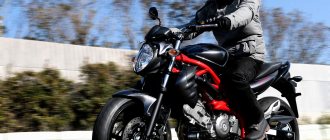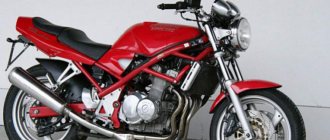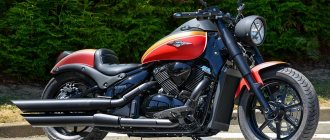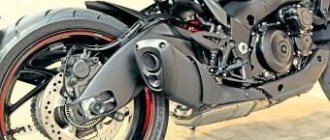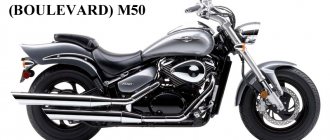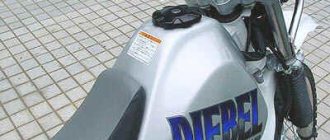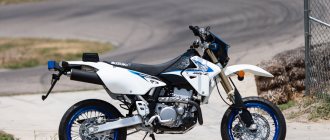| Suzuki SFV400 Gladius (2009-2017) |
Suzuki SFV 400 Gladius naked model
appeared in 2009 as a successor to the Suzuki SV400 and the “younger” version of the export Suzuki SFV650 Gladius, on the basis of which the Gladius 400 was built. The motorcycle was developed for the domestic Japanese market and was not officially exported to other countries.
The Suzuki SFV400 Gladius model is almost identical to the Suzuki SFV650 Gladius, and differs from it only in engine size. Also, the Gladius 400 has ABS as standard equipment (the Gladius 650 came standard with ABS only for European countries).
The model was based on a 2-cylinder V-shaped (90°) liquid-cooled engine with a volume of 399 cm³ and producing 55 hp. power and 41 Nm of torque. Due to the characteristic forward tilt of the cylinders, this engine layout is often called L-shaped. The intake system is completely identical to the older version and is an injector with two 39 mm throttle valves and an SDTV system (Suzuki Dual Throttle Valve).
The chassis of the motorcycle is presented in the form of a steel tubular frame, simple suspension (adjustable for preload) and a simple 2-piston braking system at the front (with ABS).
Unlike the Suzuki SFV650 Gladius, the domestic Japanese Suzuki SFV400 Gladius was produced until mid-2022, after which it left the assembly line and was no longer offered. Currently, this model is widely represented at Japanese auctions, which makes it available for purchase and export to the Russian Federation.
Model range of the Suzuki Gladius series:
- Suzuki SFV400 Gladius
- Suzuki SFV650 Gladius
The main competitors of the Suzuki Gladius 400 in the class:
- Honda CB500F
- Kawasaki ER-4
Brief history of the model
- 2009 - start of production and sales of the Suzuki SFV 400 Gladius model.
Model
: Suzuki Gladius 400 ABS (Japan).
Factory designation
: SFV400AK9.
- 2010 - no significant changes.
Model
: Suzuki Gladius 400 ABS (Japan).
Factory designation
: SFV400AL0.
- 2011 - no significant changes.
Model
: Suzuki Gladius 400 ABS (Japan).
Factory designation
: SFV400AL1.
- 2012 - no significant changes.
Model
: Suzuki Gladius 400 ABS (Japan).
Factory designation
: SFV400AL2.
- 2013 - no significant changes.
Model
: Suzuki Gladius 400 ABS (Japan).
Factory designation
: SFV400AL3.
- 2014 - no significant changes.
Model
: Suzuki Gladius 400 ABS (Japan).
Factory designation
: SFV400AL4.
- 2015 - no significant changes.
Model
: Suzuki Gladius 400 ABS (Japan).
Factory designation
: SFV400AL5.
- 2016 - no significant changes.
Model
: Suzuki Gladius 400 ABS (Japan).
Factory designation
: SFV400AL6.
- 2017 is the last year of production.
Model
: Suzuki Gladius 400 ABS (Japan).
Factory designation
: SFV400AL7.
Specifications
Technical characteristics of Suzuki SFV 400 Gladius:
| Model | Suzuki Gladius 400 |
| Motorcycle type | naked |
| Year of issue | 2009-2017 |
| Frame | steel tubular |
| engine's type | 2-cylinder, 4-stroke, V-shaped 90° (L-shaped) |
| Working volume | 399 cm³ |
| Bore/Stroke | 72.0 x 49.0 mm |
| Compression ratio | 11.8:1 |
| Cooling | liquid |
| Number of valves per cylinder | DOHC, 4 valves per cylinder |
| Fuel supply system | Injector with SDTV (Suzuki Dual Throttle Valve System), 2x 39 mm |
| Ignition type | transistor |
| Maximum power | 55.0 hp (41.0 kW) at 11000 rpm |
| Maximum torque | 41.0 Nm (4.2 kg*m) at 8500 rpm |
| Clutch | Multi-disc in oil bath, cable drive |
| Transmission | 6-speed |
| type of drive | chain |
| Front tire size | 120/70ZR17M/C (58W) |
| Rear tire size | 160/60ZR17M/C (69W) |
| Front brakes | 2 discs, 290 mm, 2-piston calipers (ABS) |
| Rear brakes | 1 disc, 240 mm, 1-piston caliper (ABS) |
| Front suspension | 41mm telescopic fork (preload adjustable), 125mm travel |
| Rear suspension | Pendulum with monoshock absorber (preload adjustment), stroke - 130 mm |
| Motorcycle length | 2130 mm |
| Motorcycle width | 760 mm |
| Motorcycle height | 1090 mm |
| Wheelbase | 1445 mm |
| Seat height | 785 mm |
| Minimum ground clearance (clearance) | 135 mm |
| Acceleration 0-100 km/h (0-60 mph) | 5.6 sec. |
| Maximum speed | 180 km/h |
| Gas tank capacity | 14.0 l |
| Motorcycle weight (curb) | 206 kg |
Suzuki SVF 400 (Gladius 400)
Brief review of Suzuki SVF 400 (Gladius 400)
The Suzuki SVF 400 road motorcycle model, also known as the Gladius 400, is a domestic Japanese version of the 650 cc modification intended for European countries. It took the place of the discontinued Suzuki SV 400 model, and is actually its modified version, with a more modern appearance and a slightly modified engine. The SV 400 was a successful and popular model, and the Gladius 400, by and large, differs from it mainly in appearance and price.
The Suzuki Gladius 400 differs from many other 400 cc motorcycles in having a V-shaped engine (more precisely, an L-shaped one, since the cylinder camber angle is 90 degrees) instead of an in-line one. The engine pulls well even from low speeds, something that small-capacity “in-line” engines rarely boast of, which provides the motorcycle with smooth acceleration. Otherwise, the technical characteristics of the Gladius 400 are almost identical to those of other motorcycles of the same class and similar cubic capacity. During production, the motorcycle did not change in any way, with the exception of the ABS system, which began to be installed on the SVF 400 in 2010.
Similar motorcycles:
- Honda CB500F
- Kawasaki ER-4
- Suzuki SV 400
Technical characteristics of Suzuki SVF 400 (Gladius 400)
- Years of production: since 2009
- Class: road
- Frame: spatial steel
- Engine: 4-stroke, 2-cylinder, V-shaped
- Engine capacity, cubic meters see: 399
- Cooling: liquid
- Valves per cylinder: 4
- Fuel supply: injector
- Power: 55 hp at 11000 rpm
- Torque: 41 Nm at 8500 rpm
- Maximum speed, km/h: 180
- Acceleration from 0 to 100 km/h: ~5.6 seconds
- Transmission: 6-speed
- Wheel drive: chain
- Front tire: 120/70-17
- Rear tire: 160/60-17
- Front brakes: 2 discs 290 mm, 2-piston calipers, ABS
- Rear brakes: 1 disc 240 mm, 1-piston caliper, ABS
- Front suspension: telescopic fork
- Rear suspension: monoshock absorber with pretension adjustment
- Gas tank volume, liters: 14
- Fuel consumption at 110 km/h, liters: ~4.5
- Curb weight, kg: ~206
Pros and advantages of Suzuki SVF 400 (Gladius 400)
- Low fuel consumption
- Comfortable fit
- ABS brakes
- Smooth thrust of the V-shaped engine
- Reliable and proven design
Pros and cons of Suzuki SVF 400 (Gladius 400)
- Overpriced compared to the previous model - SV 400
- Weak front fork that breaks on road irregularities
- Small gas tank
- Lack of wind protection
- Heavy weight
Reviews
Reviews of Suzuki SFV 400 Gladius:
Expand Collapse
Gladius is once again an improved version of the proven SV400. An excellent moto for a beginner. Serve on time and enjoy life.
The Gladius is essentially an SV400.
The suspension is weak, especially in front. It cracks in any pits, this is not enduro. Even after a breakdown, the disc bends quite a bit - the rubber profile is low, especially in corners.
If you want a smooth ride on our shit roads, take the DL650 V-Strom. The best choice for Russia.
Suzuki SV650 / SV650A / SV650S / SV650SA
01.07.2004During comparison tests, some people unduly exaggerate small differences, but in this case, each of the three bikes is a winner, as they are all simply great motorcycles. However, the FZ6 is the fastest, best handling and most comfortable, while the SV650 is the fastest, most agile and has the most character...
When many of us first started riding, there were only two types of two-wheeled motorized vehicles: scooters and motorcycles. Heck, it was even quite difficult to draw a clear line between road cars and SUVs! After the Japanese started selling bikes in our country, the situation changed a little, but a lot of time passed before truly clear categories of motorcycles began to appear on the market.
Over the past few years preceding the new millennium, and today, independent categories have begun to appear on the motorcycle market within the main categories. For example, once we had broadly defined what motorcycles were classified as “adventure tourers,” the Suzuki V-Strom came along with alloy wheels instead of traditional spoked wheels, ushering in a new category: the “sporty” adventure tourer. Cruisers used to be just cruisers, but now they are divided into high-tech, touring and custom models.
If we talk about touring motorcycles, is it possible to give a clear definition of a sports touring model these days? I think it's impossible. And I can’t even give such a definition, because all motorcycles, starting with the Yamaha FZ1 and ending with the Honda ST1300, can, to one degree or another, be classified in this category. No, I'm not exactly complaining, but would it be bad if we got some new bikes that were just "motorcycles"? Perhaps these three models can be called “just” motorcycles.
The Honda 599, Suzuki SV650 and Yamaha Z6 motorcycles have sporting characteristics, but they are not “sport bikes,” “naked” bikes, or anything else. Each of these bikes can be used for touring, but they are not touring bikes and cannot be called cruisers. But, most importantly, the price of these cars is more in line with the normal cost of a “motorcycle”, and does not approach the prices of cars.
Although the SV650 has been around since 1999, once it was joined by the 599 and FZ6 this year, the Kawasaki ZR-7S and Suzuki Bandit 600 bikes could no longer compete in this category, and now it remains the same number of multi-function, stripped, standard "motorcycles" (sorry for being trivial) of average weight, each costing between US$6,000 and US$7,000. Some may wonder why alternatives like the Suzuki SV650S and Triumph Speed Four aren't included in our test. Although they cost about the same, their lower positioned handlebars and set-back footpegs make them classed as sport bikes, so we'll save them for future test rides.
We've previously individually tested the 599, SV650 and FZ6, so we're familiar with their features and benefits. All of these bikes are liquid-cooled, have six speeds, a chain final drive, and 17-inch alloy wheels front and rear with good radial tires. All three machines only have rear spring preload adjustment, with the exception of the Suzuki, which also has front spring preload adjustment (but this adjustment is really just for show), and all have solid 41-inch fork tubes. 43 mm. Additionally, other similar features include a tube handlebar, adjustable brake levers, a three-disc brake system, dual-piston calipers at the front and a single-piston caliper at the rear.
Unlike its competitors, the Suzuki model is not such a traditional and conformist motorcycle. It is powered by a pulsating 645cc V-twin. cm with a cylinder camber angle of 90 degrees and a DOHC system. The Suzuki has two fewer cylinders and about 45 cc more compared to Honda and Yamaha's fast, inline-four DOHC engines, which are based on the CBR-F3 and R6 sportbikes. Additionally, the SV650 is the only 2003 motorcycle among the machines we test here. Suzuki is reportedly working hard to improve the ergonomics of all its 2004 SV650 and SV1000 models, but this is the only upcoming change to the bikes, other than the new colors that will appear early in 2004. Compared to 2003, prices will remain unchanged.
Both the SV650 and FZ6 are equipped with injection systems, and the engine of the Honda 599 motorcycle, like the engine on which it is based (CBR600), is carburetor, so the choke lever is installed on the steering handle. The 599's engine is mounted on a steel frame, while the FZ6 and SV650 have aluminum frames, but in terms of weight, the Honda is positioned between the heaviest FZ6 and the lightest, the SV650.
In Venter, Calif.-based My Garage's My Garage Dynojet dyno comparison tests, the FZ6 wins in terms of peak rear-wheel power. The Yamaha engine developed 90.5 horsepower at approximately 11,800 rpm, while the 599 motorcycle engine showed 83.6 horsepower. at 11700, and SV650 – 73.4 hp. at 8800 rpm. But the Suzuki model takes first place in terms of peak torque, which is 47.2 lbf-ft (64 Nm) at 7000 rpm, as opposed to 43 lbf-ft (58.3 Nm) at 8500-9000 rpm ./min., which are produced by the engines of the other two bikes.
But note that the SV650 produces significantly more torque and power from idle to 9,000 rpm than the 599 and FZ6. In other words, the Suzuki motorcycle has more power in the part of the distribution that is used most often. What's more, the SV650's curb weight is just 436 lbs (197.5 kg), which is 11-22 lbs (5-10 kg) lighter than the other two models, so it's no surprise that it outperforms them if the speed is not exceeded permissible (traffic rules) limit.
Dynamic test data defines clear characteristics of these motorcycles and gives the rider a certain feeling. While the FZ6 and 599 bikes have moderate-to-good bottom- and mid-range power and can be used for quick, hassle-free daily commuting or touring, it requires shifting more often to keep the motors in their proper distribution ranges. When it comes to fast straightaways or mountain roads, these bikes cannot be used effectively until their inline-fours reach higher speeds.
In this case, the FZ6 bike “screams the loudest”, whose red zone begins at 14,000 rpm, which is 2,000 rpm higher than the Honda. On the other hand, the SV650 forces the throttle wide open, often at slow engine speeds, and the rider is rewarded with powerful thrust and a deafening growl from the twin-cylinder engine's exhaust system. However, as the revs approach the 10,000 rpm redline, all the traction from the bike quickly disappears.
Surprisingly, the SV650 is significantly softer than the other two bikes, and the rider feels either no or very little vibration in the saddle, footpegs and handlebars. FZ6 riders will quickly get used to the occasional saddle shake, but 599 riders will find the vibrations across much of the distribution, affecting the hips and arms, to be quite annoying.
Shifts on the 599 and SV650 have a quiet clicking sound, but the FZ6 requires sharper shifting and produces an unpleasant clicking sound when engaging gears, although this gradually became less noticeable as the miles wore on. On the SV650 and FZ6 bikes you feel the clutch wonderfully, but on the 599 the clutch engages at the very extreme position of the lever stroke, and you get the feeling that the clutch is somewhat weak.
Speaking of ergonomics, it can be noted that all of these bikes have the same, mostly upright riding position, and approximately the same legroom, but long trips reveal distinctive features. The appearance of the seats can be misleading - the SV650's saddle looks thin, but is actually quite comfortable, while the 599 and FZ6 two-up seats are too thin and therefore hard.
The FZ6 has the most upright riding position and more legroom for larger riders and those who enjoy touring, especially in cold weather, thanks to its compact body kit and windshield. Next up is the SV650, which has slightly lower handlebars and higher footpegs, although you literally have to jump from the SV650 to the FZ6 to really feel the difference. Finally, the 599 has the sportiest riding position, with the handlebars positioned lower, although the foot pegs are set at about the same height as the SV650.
Overall, if you don't mind moderate vibrations and a hard seat, the FZ6 is the most comfortable bike; it's followed closely by the SV650, which has a smooth and relatively well-padded saddle. Among the three machines tested, the 599 is significantly inferior in comfort and takes third place, as it has a thin saddle, serious vibrations and less comfortable ergonomics. Despite being a bike that approaches the performance of a touring machine (as opposed to a sport racing bike), when you climb out of the saddle of the 599 you physically feel like you've ridden it, whereas riding the SV650 and FZ6 gives you the same feeling and the same amount of power as before you started the ride.
All three cars have about the same quick and sporty handling, although the FZ6 model has a slight advantage. Perhaps the experience gained in developing the nimble, maneuverable Yamaha FZ1 is telling: when entering narrow turns, the bike seems to pick up telepathic signals from the driver, but at the same time, in fast and sweeping turns, it clearly maintains its trajectory and is highly stable. The response of the SV650 and 599 motorcycles is very slightly inferior to the Yamaha. The suspension of all three cars is quite primitive and requires modernization, since when passing the middle of a turn, the bumpy road surface tends to destabilize the suspension.
The SV650's stock settings offer the best balance of compliance and dampening for all rides, while the 599's suspension is on the firmer side and the FZ6's is too soft. But, again, this is one of those areas where the average rider will find it very difficult to tell the difference without testing all three machines back to back. The same can be said about braking, which is strong and linear in all three cars front and rear, although the FZ6's front brake system has a touch more usable power.
When comparing parts of the bikes, it's hard to take your eyes off the FZ6's fairing and windshield, especially when it's cold outside. In addition, this bike has a central (parking) stand, the largest gas tank and a much longer interval between valve adjustments, although it is equipped with a cartridge-type filter element, unlike the more convenient screw-on oil filters found on the 599 and SV650 bikes. Each bike has two tripmeters (odometers), tachometers and clocks, under-seat racks and handlebars for the passenger (although the second saddle on each machine is uncomfortable, and there is not much room for the passenger). But if you're planning on touring on a motorcycle, we'd give a slight preference to the FZ6.
All things considered, we'd give the Yamaha the top spot if it weren't for the SV650's remarkable V-twin (which is also $600 cheaper). Of the three cars on test, this bike is the most fun and enjoyable to ride thanks to the punchy, lively character of the engine, although the FZ6 is as good as the SV650 in the corners and will cover more motorway distance. If we had both bikes at our disposal, we'd use the SV650 for Sunday fun rides, but if we were planning longer sport-touring trips with little luggage, we'd go with the FZ6.
The 599 has its own place and is considered by some to have the best styling of the other two bikes, but its lack of performance, harsh suspension, significant vibrations and more restrictive ergonomics don't make it worth it. , that this motorcycle costs 600-1200 dollars more.
During comparison tests, some journalists tend to unduly exaggerate small differences, but in this case, each of the three bikes is a winner, as they are all simply great motorcycles. However, the FZ6 is the fastest, best handling and most comfortable, while the SV650 is the fastest, most agile and has the most character. Considering the price of motorcycles, you should pay attention to both machines.
Specifications
:
2004 Honda 599
Engine
Type: in-line transverse four-cylinder, liquid cooled Volume: 599 cc cm Bore and stroke: 65.0 x 45.2 mm Compression: 12.0:1 Valves: DOHC, 4 valves per cylinder Valve adjustment interval: 16,000 miles (25,600 km) Fuel system: 4 Keihin 34 mm CV carburetors (with variable diffuser) Lubrication system: oil pan, 4.0 quart (3.8 liters) Transmission: six-speed, wet clutch, cable Final drive: O-ring chain
Electrical system
Ignition: digital electronic Power: 340 W (maximum) Battery: 12 V, 6 Ah
Chassis
Frame: Rectangular cross-section steel carrier tube with aluminum rear swingarm Wheelbase: 55.9 in (142 cm) Column angle/trail: 25.0 degrees / 3.9 in (9.9 cm) Saddle height: 31.1 in. (80 cm) Front Suspension: Non-adjustable fork with 41 mm diameter tubes, 4.3 in. (11 cm) travel Rear Suspension: Single link-type shock absorber, spring preload adjustable, 5 travel, 0 in. (12.7 cm) Front Brake: Dual discs with dual-piston floating calipers Rear Brake: Single disc with single-piston floating calipers Front Wheel: Alloy, 3.50 x 17 in. Rear Wheel: Alloy, 5.50 x 17 in. Front Tire : 120/70-ZR17 Rear Tire: 180/55-ZR17 Curb Weight: 447 lbs (202.5 kg) Load: 378 lbs (171.2 kg) GVWR - Maximum Load Weight: 825 lbs (373.7 kg)
Characteristics
Fuel tank capacity: 4.5 gallons (17 liters), including 0.7 gallons (2.65 liters) reserve Average fuel consumption: 41.3 mpg (66 km/3.79 cu in) Estimated mileage without refueling: 186 miles (297.6 km) RPM at 60 mph (96 km/h): 4350
2003 Suzuki SV650
Engine
Type: 90-degree transverse V-twin Capacity: 645 cc cm Bore and stroke: 81.0 x 62.6 mm Compression: 11.5:1 Valves: DOHC, 4 valves per cylinder Valve adjustment interval: 15,000 miles (24,000 km) Fuel system: electronic injection Lubrication system: oil crankcase, 2.5 quarts (2.375 liters) Transmission: six-speed, wet clutch, cable Final drive: O-ring chain
Electrical system
Ignition: digital electronic Power: 375 W at 5000 rpm. Battery: 12 V, 10 Ah
Chassis
Frame: Diagonal aluminum alloy frame with rectangular cross-section aluminum rear swingarm Wheelbase: 56.5 inches (143.5 cm) Column angle/trail: 25.0 degrees / 3.9 inches (10 cm) Saddle height: 31 .5 in. (80 cm) Front Suspension: 41 mm tube fork, preload adjustable, 5.1 in. (13 cm) travel Rear Suspension: single link-type shock, spring preload adjustable 5.4 in. (13.7 cm) travel Front Brake: Dual disc with dual-piston floating caliper Rear Brake: Single disc with single-piston floating caliper Front: Cast, 3.50 x 17 in. Rear: Cast, 4.50 x 17 in. Front Tire: 120/60-ZR17 Rear Tire: 160/60-ZR17 Curb Weight: 436 lbs (197.5 kg) Load: 449 lbs (203.4 kg) GVWR - Maximum Load Weight: 885 lbs (400.9 kg)
Characteristics
Fuel tank capacity: 4.5 gallons (17 liters), fuel warning indicator at 1.1 gallons (4.17 liters) remaining Average fuel consumption: 39.8 mpg (63.7 km at 3.79 cu in ) Estimated range without refueling: 179 miles (286.4 km) RPM at 60 mph (96 km/h): 4650
2004 Yamaha FZ6
Engine
Type: in-line transverse four-cylinder, liquid cooled Volume: 600 cc cm Bore and stroke: 65.5 x 44.5 mm Compression: 12.2:1 Valves: DOHC, 4 valves per cylinder Valve adjustment interval: 26,600 miles (42,560 km) Fuel system: electronic injection Lubrication system: oil crankcase, 3.0 quart (2.85 liters) Transmission: six-speed, wet clutch, cable Final Drive: O-ring chain
Electrical system
Ignition: digital electronic Power: 322 W at 5000 rpm. Battery: 12 V, 10 Ah
Chassis
Frame: Diamond aluminum perimeter with rectangular cross-section aluminum rear swingarm Wheelbase: 56.7 in (144.0 cm) Column/Trail angle: 25.0 degrees / 3.8 in (9.7 cm) Height Seat: 31.3 in (79.5 cm) Front Suspension: 43 mm tube fork, 5.1 in (13 cm) travel Rear Suspension: Single shock, spring preload adjustable, 5.1 in (travel) 13 cm) Front Brake: Dual Disc with Dual-Piston Floating Caliper Rear Brake: Single Disc with Single-Piston Floating Caliper Front Wheel: Alloy, 3.50 x 17" Rear Wheel: Alloy, 5.50 x 17" Front Tire: 120/70- ZR17 Rear Tire: 180/55-ZR17 Curb Weight: 458 lbs (207.5 kg) Load: 417 lbs (189 kg) GVWR - Maximum Load Weight Rating: 875 lbs (396.4 kg)
Characteristics
Fuel tank capacity: 5.1 gallons (19.3 liters), fuel warning indicator at 1.0 gallons (3.79 liters) remaining Average fuel consumption: 39.4 mpg (63 km at 3.79 cu in ) Estimated range without refueling: 201 miles (321.6 km) RPM at 60 mph (96 km/h): 5000
Source: https://www.bikeland.ru/rus/news/salonnews/?action=show&id=1479
